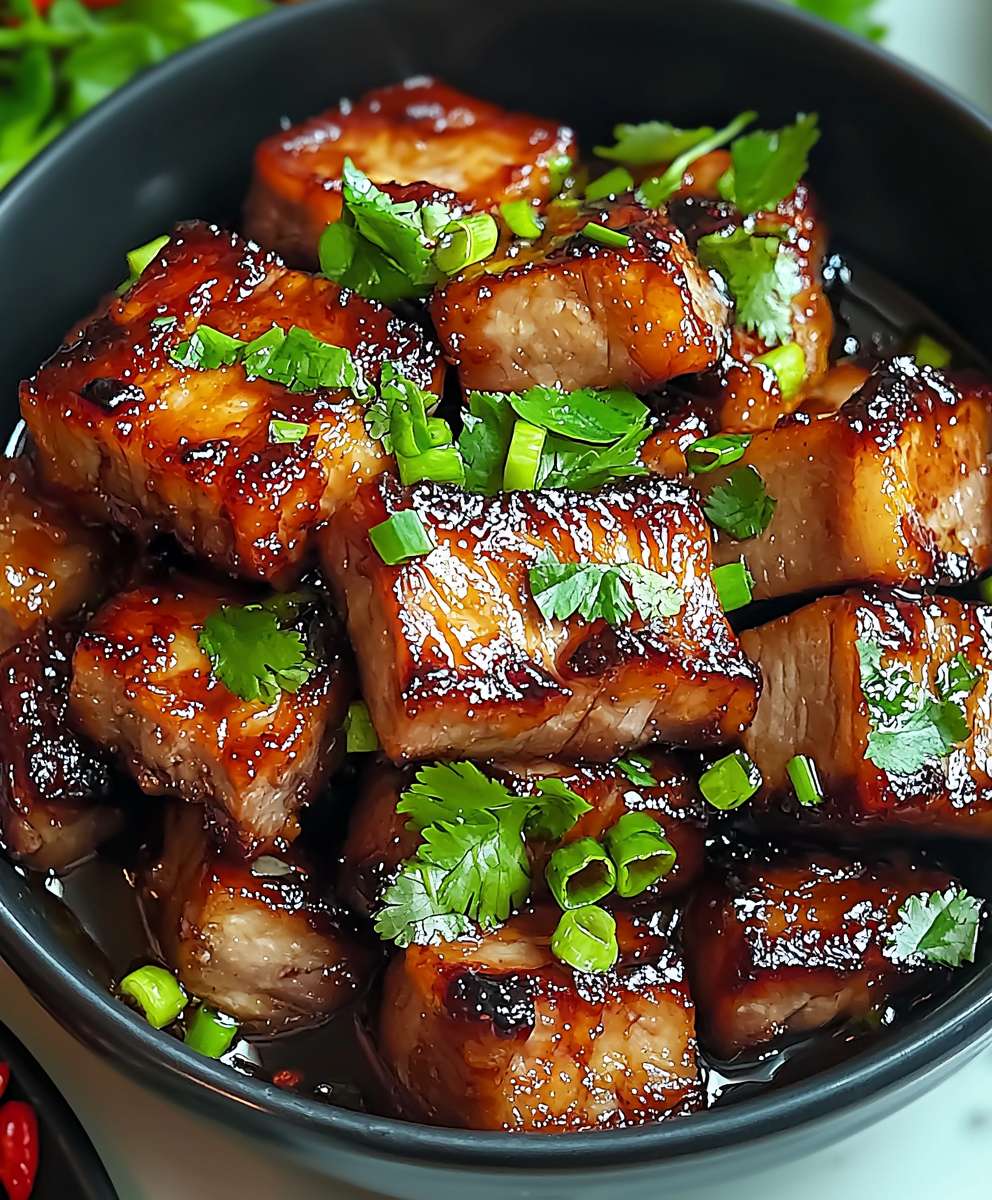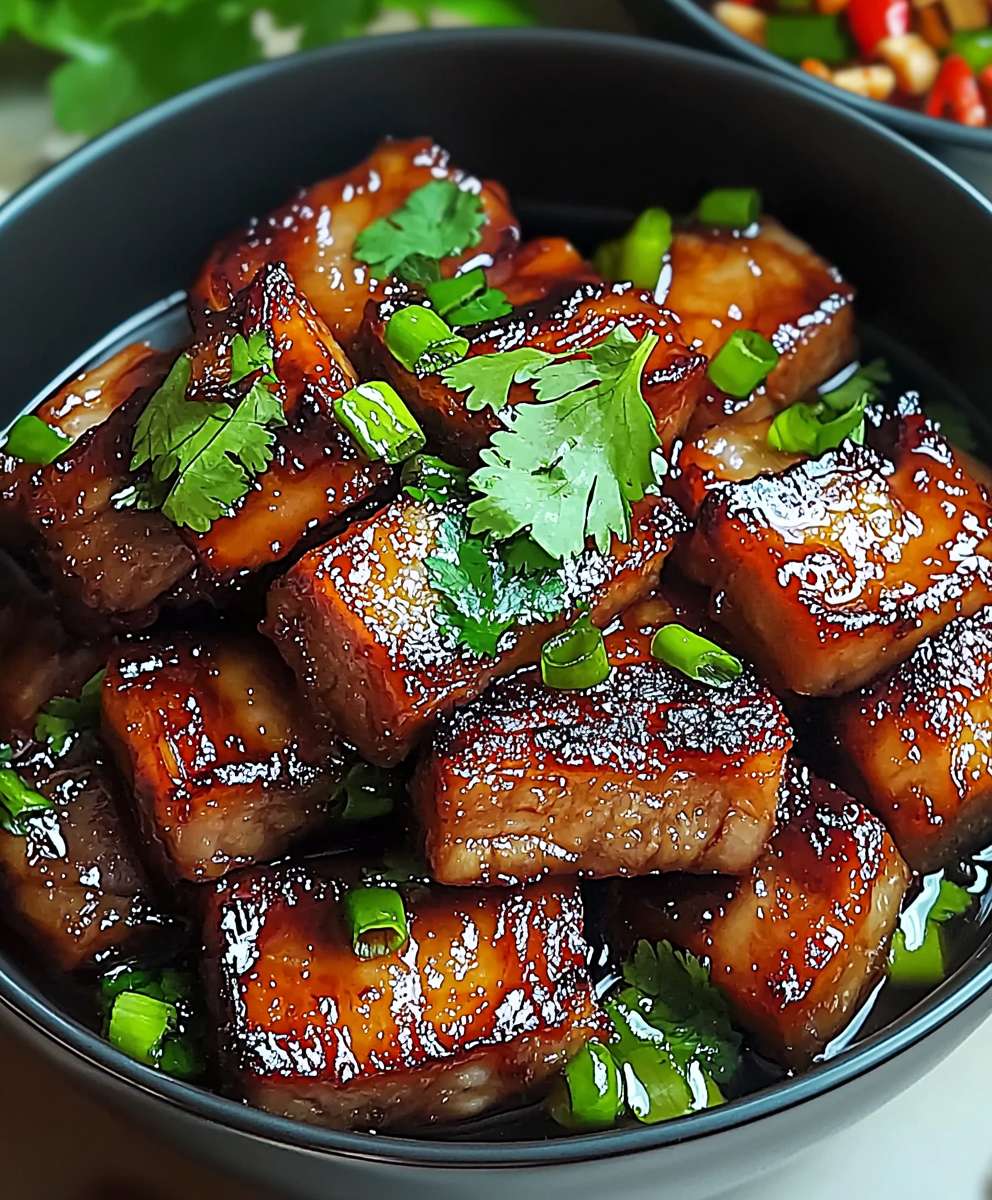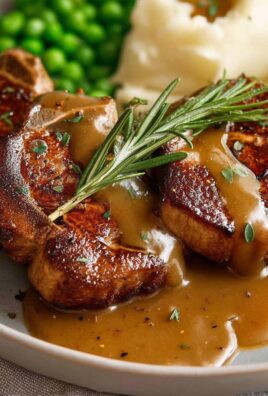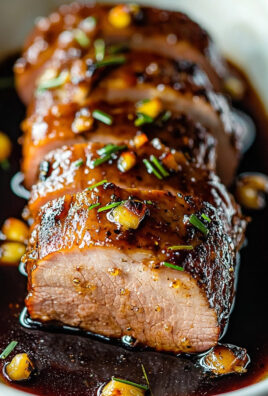Caramelized Vietnamese Pork, or Thit Kho Tau as it’s known in Vietnam, is a dish that whispers of home, family gatherings, and the rich culinary heritage of Southeast Asia. Imagine tender, melt-in-your-mouth pork belly, braised to perfection in a sweet and savory caramel sauce, its glistening surface promising an explosion of flavor with every bite. Have I got your attention? This isn’t just a recipe; it’s an experience!
This iconic dish is more than just a meal; it’s a cultural cornerstone, often prepared during T?t, the Vietnamese Lunar New Year. The slow braising process symbolizes prosperity and good fortune for the year ahead. Passed down through generations, each family boasts their own unique twist, a secret ingredient or a slightly different technique that makes their Caramelized Vietnamese Pork truly special.
But what makes this dish so universally loved? It’s the perfect balance of sweet, salty, and savory. The tender pork, infused with the rich caramel sauce, offers a delightful contrast in textures. It’s also incredibly versatile! Serve it with steamed rice for a comforting weeknight dinner, or alongside pickled vegetables for a more festive occasion. Plus, it’s surprisingly easy to make, requiring minimal effort for maximum flavor. So, are you ready to embark on a culinary journey and create your own version of this beloved Vietnamese classic? Let’s get cooking!
Ingredients:
- 2 lbs pork shoulder, cut into 1-inch cubes
- 2 tablespoons vegetable oil
- 1 large onion, thinly sliced
- 4 cloves garlic, minced
- 1 inch ginger, peeled and minced
- 1/2 cup granulated sugar
- 1/4 cup fish sauce
- 2 tablespoons soy sauce
- 1 tablespoon dark soy sauce (for color, optional)
- 1 teaspoon black pepper
- 1/2 teaspoon red pepper flakes (optional, for heat)
- 2 cups water or coconut water
- 2 green onions, thinly sliced, for garnish
- Cooked rice, for serving
Preparing the Pork and Aromatics
- First, let’s get our pork ready. Pat the pork shoulder cubes dry with paper towels. This will help them brown nicely when we sear them.
- Now, heat the vegetable oil in a large, heavy-bottomed pot or Dutch oven over medium-high heat. You want the oil to be shimmering, but not smoking.
- Add the pork cubes to the pot in a single layer, being careful not to overcrowd. If you overcrowd the pot, the pork will steam instead of sear. Work in batches if necessary. Sear the pork on all sides until nicely browned, about 2-3 minutes per side. This browning is crucial for developing deep flavor.
- Once the pork is browned, remove it from the pot and set it aside. Don’t worry about cooking it all the way through at this point; we’ll be braising it later.
- Reduce the heat to medium and add the sliced onion to the pot. Cook, stirring occasionally, until the onion is softened and translucent, about 5-7 minutes. Scrape up any browned bits from the bottom of the pot these are packed with flavor!
- Add the minced garlic and ginger to the pot and cook for another minute, until fragrant. Be careful not to burn the garlic, as it can become bitter.
Creating the Caramel and Braising the Pork
- Now for the fun part: making the caramel! Push the onions, garlic, and ginger to one side of the pot. Add the granulated sugar to the empty side of the pot.
- Let the sugar melt undisturbed over medium heat. It will start to clump together and then gradually melt into a golden-brown liquid. Watch it carefully, as it can burn quickly.
- Once the sugar is completely melted and a deep amber color (like maple syrup), carefully stir in the fish sauce, soy sauce, and dark soy sauce (if using). Be careful, as the mixture will bubble and splatter when you add the liquids.
- Stir until the caramel is dissolved and the sauce is smooth. This might take a minute or two.
- Add the black pepper and red pepper flakes (if using) to the sauce.
- Return the browned pork to the pot and stir to coat it evenly with the caramel sauce.
- Pour in the water or coconut water. The liquid should almost cover the pork. If needed, add a little more water.
- Bring the mixture to a simmer, then reduce the heat to low, cover the pot, and let it braise for at least 2-3 hours, or until the pork is very tender and easily shreds with a fork. The longer it braises, the more flavorful it will become. Check the pot occasionally and add more water if needed to prevent it from drying out.
Reducing the Sauce and Serving
- Once the pork is tender, remove the lid from the pot and increase the heat to medium. Let the sauce simmer and reduce until it thickens to a syrupy consistency. This will take about 20-30 minutes, depending on how much liquid is left in the pot. Stir occasionally to prevent the sauce from sticking to the bottom of the pot.
- Taste the sauce and adjust the seasoning if needed. You might want to add a little more fish sauce for saltiness, sugar for sweetness, or pepper for heat.
- Shred the pork with two forks. It should be incredibly tender and fall apart easily.
- Stir the shredded pork back into the reduced sauce and let it simmer for a few more minutes to absorb the flavors.
- Serve the caramelized Vietnamese pork hot over cooked rice. Garnish with thinly sliced green onions.
Tips for Success:
- Don’t rush the caramelization process. The deep amber color of the caramel is essential for the flavor of the dish.
- Use a heavy-bottomed pot or Dutch oven. This will help to distribute the heat evenly and prevent the pork from burning.
- Braising time is key. The longer the pork braises, the more tender and flavorful it will become.
- Adjust the seasoning to your taste. This recipe is a guideline, so feel free to adjust the amount of fish sauce, sugar, and pepper to your liking.
- Coconut water adds a subtle sweetness. If you don’t have coconut water, you can use regular water instead.
- Serve with your favorite sides. This dish is delicious with steamed vegetables, pickled vegetables, or a simple salad.
Variations:
- Add hard-boiled eggs. Hard-boiled eggs are a common addition to Vietnamese braised pork dishes. Add them to the pot during the last hour of braising.
- Add potatoes or carrots. These vegetables will add sweetness and heartiness to the dish. Add them to the pot during the last hour of braising.
- Make it spicier. Add more red pepper flakes or a chopped chili pepper to the pot.
- Use a different cut of pork. Pork belly or pork ribs can also be used in this recipe. Adjust the braising time accordingly.
Storage:
- Leftover caramelized Vietnamese pork can be stored in an airtight container in the refrigerator for up to 3-4 days. Reheat gently on the stovetop or in the microwave.
- This dish also freezes well. Store in an airtight container in the freezer for up to 2-3 months. Thaw overnight in the refrigerator before reheating.

Conclusion:
So, there you have it! This recipe for Caramelized Vietnamese Pork is truly a game-changer. It’s not just another pork dish; it’s an explosion of sweet, savory, and umami flavors that will dance on your taste buds. The tender, juicy pork, coated in that luscious, sticky caramel sauce, is simply irresistible. I promise, once you try it, you’ll be adding it to your regular rotation of weeknight dinners.
But why is this recipe a must-try? Well, beyond the incredible flavor profile, it’s surprisingly easy to make. Don’t let the “caramelized” part intimidate you. The process is straightforward, and I’ve broken down each step to ensure success, even for novice cooks. Plus, the ingredients are readily available at most grocery stores, so you won’t have to embark on a wild goose chase to find exotic spices. It’s a delicious, impressive meal that you can whip up without spending hours in the kitchen. What’s not to love?
And the versatility! Oh, the possibilities are endless. While I personally love serving this Caramelized Vietnamese Pork over a bed of fluffy jasmine rice, you could also try it with quinoa or brown rice for a healthier option. For a low-carb alternative, serve it with cauliflower rice or alongside a vibrant salad of mixed greens and crunchy vegetables.
Serving Suggestions and Variations:
* Banh Mi Filling: Shred the pork and use it as a filling for banh mi sandwiches, complete with pickled vegetables, cilantro, and a smear of mayonnaise.
* Noodle Bowls: Toss the pork with rice noodles, fresh herbs, bean sprouts, and a drizzle of fish sauce for a refreshing and satisfying noodle bowl.
* Lettuce Wraps: Serve the pork in lettuce cups with a sprinkle of peanuts and a squeeze of lime for a light and flavorful appetizer or snack.
* Stir-Fry: Add the caramelized pork to your favorite stir-fry recipe for an extra boost of flavor and protein.
* Spice it Up: If you like a little heat, add a pinch of red pepper flakes or a dash of sriracha to the marinade.
* Make it Vegetarian: Substitute the pork with firm tofu or tempeh for a vegetarian-friendly version. Just be sure to press the tofu well to remove excess moisture before marinating.
I truly believe that this recipe for Caramelized Vietnamese Pork is a winner. It’s a crowd-pleaser, a flavor bomb, and a relatively simple dish to prepare. It’s the kind of meal that will have your family and friends begging for seconds (and the recipe!).
So, what are you waiting for? Head to the kitchen, gather your ingredients, and get ready to experience the magic of Caramelized Vietnamese Pork. I’m confident that you’ll love it as much as I do.
And most importantly, I want to hear about your experience! Did you try the recipe? Did you make any variations? What did you think? Share your photos and comments on social media using [Your Hashtag Here] or leave a comment below. I can’t wait to see your culinary creations and hear your feedback. Happy cooking! I hope you enjoy this recipe for Caramelized Vietnamese Pork as much as I do!
Caramelized Vietnamese Pork: A Deliciously Simple Recipe
Tender pork shoulder braised in a rich caramel sauce with fish sauce, soy sauce, and aromatics. A classic Vietnamese comfort food.
Ingredients
- 2 lbs pork shoulder, cut into 1-inch cubes
- 2 tablespoons vegetable oil
- 1 large onion, thinly sliced
- 4 cloves garlic, minced
- 1 inch ginger, peeled and minced
- 1/2 cup granulated sugar
- 1/4 cup fish sauce
- 2 tablespoons soy sauce
- 1 tablespoon dark soy sauce (for color, optional)
- 1 teaspoon black pepper
- 1/2 teaspoon red pepper flakes (optional, for heat)
- 2 cups water or coconut water
- 2 green onions, thinly sliced, for garnish
- Cooked rice, for serving
Instructions
- Pat the pork shoulder cubes dry with paper towels.
- Heat vegetable oil in a large, heavy-bottomed pot or Dutch oven over medium-high heat. Add pork cubes in a single layer (work in batches if needed) and sear on all sides until nicely browned, about 2-3 minutes per side. Remove pork and set aside.
- Reduce heat to medium. Add sliced onion to the pot and cook, stirring occasionally, until softened and translucent, about 5-7 minutes, scraping up any browned bits. Add minced garlic and ginger and cook for another minute until fragrant.
- Push onions, garlic, and ginger to one side of the pot. Add granulated sugar to the empty side. Let the sugar melt undisturbed over medium heat until it becomes a deep amber color (like maple syrup).
- Carefully stir in fish sauce, soy sauce, and dark soy sauce (if using). Stir until the caramel is dissolved and the sauce is smooth. Add black pepper and red pepper flakes (if using).
- Return the browned pork to the pot and stir to coat it evenly with the caramel sauce. Pour in water or coconut water (liquid should almost cover the pork).
- Bring the mixture to a simmer, then reduce the heat to low, cover the pot, and let it braise for at least 2-3 hours, or until the pork is very tender and easily shreds with a fork. Check the pot occasionally and add more water if needed.
- Once the pork is tender, remove the lid and increase the heat to medium. Let the sauce simmer and reduce until it thickens to a syrupy consistency, about 20-30 minutes. Stir occasionally.
- Taste the sauce and adjust the seasoning if needed (more fish sauce, sugar, or pepper).
- Shred the pork with two forks. Stir the shredded pork back into the reduced sauce and let it simmer for a few more minutes. Serve hot over cooked rice, garnished with thinly sliced green onions.
Notes
- Don’t rush the caramelization process. The deep amber color of the caramel is essential for the flavor of the dish.
- Use a heavy-bottomed pot or Dutch oven. This will help to distribute the heat evenly and prevent the pork from burning.
- Braising time is key. The longer the pork braises, the more tender and flavorful it will become.
- Adjust the seasoning to your taste. This recipe is a guideline, so feel free to adjust the amount of fish sauce, sugar, and pepper to your liking.
- Coconut water adds a subtle sweetness. If you don’t have coconut water, you can use regular water instead.
- Serve with your favorite sides. This dish is delicious with steamed vegetables, pickled vegetables, or a simple salad.
- Variations: Add hard-boiled eggs, potatoes, or carrots during the last hour of braising. Make it spicier with more red pepper flakes or chopped chili pepper. Use pork belly or pork ribs (adjust braising time).
- Storage: Leftovers can be stored in the refrigerator for 3-4 days or frozen for 2-3 months.






Leave a Comment